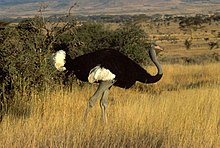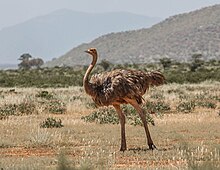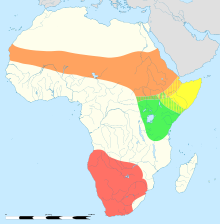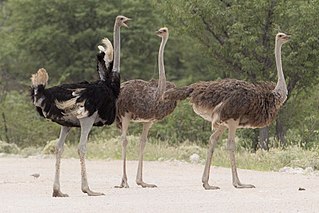
The common ostrich, or simply ostrich, is a species of flightless bird native to certain large areas of Africa and is the largest living bird species. It is one of two extant species of ostriches, the only living members of the genus Struthio in the ratite order of birds. The other is the Somali ostrich, which was recognized as a distinct species by BirdLife International in 2014 having been previously considered a distinctive subspecies of ostrich.

Struthionidae is a family of flightless birds, containing the extant ostriches and their extinct relatives. The two extant species of ostrich are the common ostrich and Somali ostrich, both in the genus Struthio, which also contains several species known from Holocene fossils such as the Asian ostrich. The common ostrich is the more widespread of the two living species, and is the largest living bird species. The extinct genus Pachystruthio from the Late Pliocene-Early Pleistocene of Eurasia is one of the largest birds ever.

The African paradise flycatcher is a medium-sized passerine bird. The two central tail feathers of the male are extended into streamers that commonly are more than twice as long as the body. The female tail feathers are of moderate length and without streamers. The upper parts of the male body, wings, and tail are boldly coloured in chestnut or rusty shades, but the underparts and the head are variably grey to blue-gray, with the head of the mature male being darker, commonly glossy black with greenish highlights. The beak and other bare areas, including a wattle ring round the eye, match the colour of the surrounding feathers. The female coloration is similar, though not so showy and glossy and with the head paler.

Flightless birds are birds that through evolution lost the ability to fly. There are over 60 extant species, including the well known ratites and penguins. The smallest flightless bird is the Inaccessible Island rail. The largest flightless bird, which is also the largest living bird, is the ostrich.

Ostriches are large flightless birds of the genus Struthio in the order Struthioniformes, part of the infra-class Palaeognathae, a diverse group of flightless birds also known as ratites that includes the emus, rheas, and kiwis. There are two living species of ostrich: the common ostrich, native to large areas of sub-Saharan Africa and the Somali ostrich, native to the Horn of Africa. The common ostrich was also historically native to the Arabian Peninsula, and ostriches were present across Asia as far east as Mongolia during the Late Pleistocene and possibly into the Holocene. They lay the largest eggs of any living land animal. With the ability to run at 70 km/h (43.5 mph), they are the fastest birds on land. They are farmed worldwide, particularly for their feathers as they are used as decoration and feather dusters. Their skin is also used for leather products. They are the heaviest living birds.
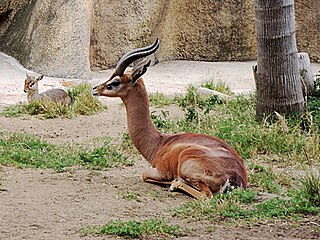
The gerenuk, also known as the giraffe gazelle, is a long-necked antelope found in parts of East Africa. The sole member of the genus Litocranius, the gerenuk was first described by the naturalist Victor Brooke in 1879. It is characterised by its long, slender neck and limbs. The antelope is 80–105 centimetres tall, and weighs between 18 and 52 kilograms. Two types of colouration are clearly visible on the smooth coat: the reddish brown back or the "saddle", and the lighter flanks, fawn to buff. The horns, present only on males, are lyre-shaped. Curving backward then slightly forward, these measure 25–44 cm.

Soemmerring's gazelle, also known as the Abyssinian mohr, is a gazelle species native to the Horn of Africa. The species was described and given its binomen by German physician Philipp Jakob Cretzschmar in 1828. Three subspecies are recognized. It is possibly no longer present in Sudan.

The Arabian ostrich, Syrian ostrich, or Middle Eastern ostrich is an extinct subspecies of the ostrich that lived on the Arabian Peninsula and in the Near East until the mid-20th century.

The crested guineafowl is a member of the Numididae, the guineafowl bird family. It is found in open forest, woodland and forest-savanna mosaics in sub-Saharan Africa.

The montane nightjar, mountain nightjar or Abyssinian nightjar, is a species of nightjar in the family Caprimulgidae. It is native to upland regions of Central and Eastern Africa where it is a locally common species.
The little brown bustard is a species of bird in the family Otididae. Found in Ethiopia and Somalia, its natural habitats are subtropical or tropical dry shrubland and subtropical or tropical dry lowland grassland. As indicated by its name, this bustard is the world's smallest at 45 cm (18 in) and 600 grams (1.3 lb). It is threatened by habitat destruction.

The white-bellied bustard or white-bellied korhaan is an African species of bustard. It is widespread in sub-Saharan Africa in grassland and open woodland habitats.

The white-browed scrub robin, also known as the red-backed scrub-robin, is a species of bird in the family Muscicapidae. It is native to sub-Saharan Africa, especially East and southern Africa. Within range, its Turdus-like song is one of the often-heard sounds of the bush. The flitting of the tail is characteristic of this species, but also of some near relatives.
An ostrich is a type of large flightless bird.

The Somali crow, or dwarf raven, is approximately the size of the carrion crow, Corvus corone but with a longer bill and a somewhat more brownish cast to the feathers, especially when worn.
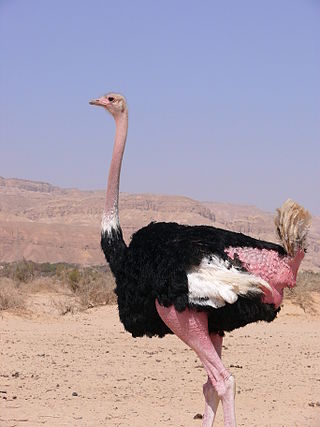
The North African ostrich, red-necked ostrich, or Barbary ostrich is the nominate subspecies of the common ostrich from West and North Africa. It is the largest subspecies, making it the largest living bird.

The South African ostrich, also known as the black-necked ostrich, Cape ostrich or southern ostrich is a subspecies of the common ostrich endemic to Southern Africa. It is widely farmed for its meat, eggs and feathers.

The Masai ostrich, also known as the East African ostrich is a red-necked subspecies variety of the common ostrich and is endemic to East Africa. It is one of the largest birds in the world, second only to its sister subspecies Struthio camelus camelus. Today it is hunted and farmed for eggs, meat, and feathers.

This is a list of the tallest extant birds according to maximum height. Birds range from a tiny bee hummingbird, which is only 5–6 cm, to the giant African ostrich, almost 280 cm in height.
